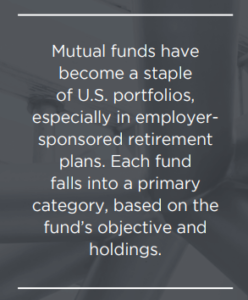Overview
If it seems like “everyone” owns a mutual fund in their portfolio, you may be on to something. In 2022, 68.6 million households (or 115.3 million individual investors) owned mutual funds, according to a survey by the Investment Company Institute (1). The survey revealed this ownership was spread across age and income groups, highlighting their appeal to a wide variety of investors.
The study also showed that half of those households were made up of baby boomers, most likely due to the longer time they’ve had to buy and hold assets. And boomers were more likely to buy mutual funds directly; more than one-third of Generation X and millennial mutual fund owners held theirs through employer sponsored retirement plans vs. 22% of boomers (2).
Although mutual funds have become a portfolio staple, many investors don’t know that there are actually different types of funds. Read on to learn more about the primary fund categories and the benefits — and some of the drawbacks — of including them in your portfolio.
A (Very) Short History of Mutual Funds
The first mutual funds were established in 1772 when an Amsterdam businessman named Adriaan van Ketwich established a trust called Eendragt Maakt Magt (“unity creates strength”). The concept was introduced in the U.S. in the 1890s, and early versions included closed-end funds offering a fixed number of shares (3).
In 1928, the original open-end mutual fund — offering redeemable shares — opened to investors in the U.S. The fund was offered as the Massachusetts Investors Trust, which is still operating 100 years later as MFS Investment Management. The Wellington Fund, which included both stocks and bonds, was introduced the following year and is also still in existence as the Vanguard Wellington Fund (VWELX)(4).
Following the passage of several regulatory acts in the 1930s and ’40s, mutual funds were required to register with the Securities and Exchange Commission (SEC). Companies offering them were also required to provide full disclosure of the funds’ holdings and how they performed in a formal document called a prospectus.
Hundreds of new mutual funds were introduced over the next 30 years, including several new types of funds. The bull market of the 1980s and ’90s made mutual funds more popular than ever, although the funds suffered big blows in the tech bubble crash in the early 2000s and the Great Recession of 2008-09. Today, there are more than 7,400 mutual funds to choose from in the U.S. (5)
Categories of Mutual Funds
Every mutual fund has unique characteristics, including target returns, objective and what assets it owns. Each fund typically falls into one of these categories, based on its holdings and overall goals:
- Money market funds invest in high-quality, short-term investments issued by governments and U.S. corporations.
- Fixed income funds pursue higher returns than money market funds by holding bonds of varying durations and types.
- Stock (or equity) funds are made up of corporate stocks.
- There are several sub-categories of stock funds, including growth funds, income funds, index funds (tracking a specific market index) and sector funds (investing in certain industries).
- Balanced funds invest in both stocks and bonds. Their focus is on achieving higher returns while reducing the potential for risk.
- Target date funds are sometimes known as lifecycle funds.
- These can include a mix of asset types, and the fund’s goals are based on “target” retirement dates. For instance, someone who plans to retire in 2030 might invest in a 2030 target date fund.
- Specialty funds have a specific investment strategy. For instance, a socially responsible fund may include stocks of companies supporting environmental conservation efforts.
- Index funds seek to match or exceed the performance of a specific index, such as the S&P 500 or the Russell 3000.
- Mortgage funds typically own commercial or residential mortgage-backed securities bonds.
- A fund of funds invests in a selection of mutual funds. Similar to balanced funds, a fund of funds is usually designed to pursue higher returns while reducing investor risk.
Benefits and Drawbacks of Mutual Funds
No matter which category a fund falls into, they offer similar benefits and drawbacks. Most investors choose mutual funds because they provide the opportunity to diversify a portfolio without purchasing and managing a long list of individual stocks. Instead, the fund manager does all the legwork  for investors, buying and selling assets in alignment with the fund’s goals.
for investors, buying and selling assets in alignment with the fund’s goals.
However, this active management can come with higher fees. Investors who wish to pay lower fees may want to explore passively managed funds, such as an index fund or exchange traded fund (ETF). Since these track existing indexes, they don’t require as much hands-on management.
Mutual fund investors can also buy and sell shares at will, much like trading stocks or bonds. This liquidity makes them an attractive option for many investors. But also like stocks or bonds, you’ll owe capital gains taxes on any realized gains when you sell mutual fund shares. And if the fund sells a security at a gain, you could end up owing taxes on that gain, even if you didn’t sell shares(6).
Finally, one of the biggest benefits to investing in mutual funds is that they’re customizable. The high number of available funds means there are many options from which to choose. And you can mix and match funds to meet your specific goals, whether your investing style is super conservative, highly aggressive or something in between.
Final Thoughts
Much like owning individual stocks and bonds, buying and selling mutual funds shouldn’t be a one-time, set-it-and-forget-it activity. Mutual funds are allowed to change investment objectives and holdings as long as they give a 30-day notice to shareholders. Additionally, over time your goals might change, and the funds you currently own may no longer be a good fit.
If a mutual fund’s objective or holdings no longer align with your goals, it may be time to sell and replace it with a different fund. Your financial advisor can assist with this review, helping you identify funds that might be a good fit for your portfolio.
1,2 Investment Company Institute. Oct. 31, 2022. “Mutual Funds Are Key to Building Wealth for Majority of US Households.” https://www.ici.org/news-release/22-news-ownership. Accessed April 14, 2023. 3 Wikipedia. “Mutual fund.” https://en.wikipedia.org/wiki/Mutual_fund. Accessed April 14, 2023. 4 James McWhinney. Investopedia. Jan. 29, 2022. “A Brief History of the Mutual Fund.” https://www.investopedia.com/articles/mutualfund/05/mfhistory.asp. Accessed April 14, 2023. 5 Statista. “Number of mutual funds in the United States from 1997 to 2021.” https://www.statista.com/statistics/255590/number-of-mutual-fund-companies-in-the-united-states/. Accessed April 14, 2023. 6 Vanguard. “How mutual funds & ETFs are taxed.” https://investor.vanguard.com/investorresources-education/taxes/how-mutual-funds-etfs-are-taxed#:~:text=Just%20as%20with%20individual%20securities,haven't%20sold%20any%20shares. Accessed April 17, 2023.
Len Hayduchok is the founder of The Delaware Retiree Connection, and the director and owner of Dedicated Financial. As a fiduciary and Certified Financial Planner, he offers his wealth of experience to guide others through the mire of financial and retirement planning. As a Certified Life Coach, he pairs his financial expertise with a heart to help others who want to make the most of their retirement plan. Investment Advisory services offered through SGL Financial LLC.
Want to talk to Len about your Retirement / Financial Plan? SCHEDULE A CONSULT









